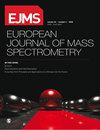用LC-HRMS和NMR对甲磺酸奥希替尼的硅预测和化学降解研究的深入研究:碱性ph介导的氧化降解产物的典型案例研究。
IF 0.8
4区 化学
Q4 PHYSICS, ATOMIC, MOLECULAR & CHEMICAL
引用次数: 0
摘要
甲磺酸奥希替尼是第三代表皮生长因子受体酪氨酸激酶抑制剂,用于治疗非小细胞肺癌。目的是了解甲磺酸奥希替尼的计算机预测和基于化学的压力测试。化学应力测试共生成8种降解产物(DPs)。在一个计算机工具中,Zeneth预测了更高的DPs百分比。采用X-Bridge C18色谱柱,以醋酸铵(以氨调pH至7.50)为流动相,乙腈为流动相,反相高效液相色谱法分离所有DPs。总体结果表明,它在酸性、碱性和氧化条件下都发生了显著的降解。在其余条件下,甲磺酸奥希替尼稳定或在光解条件下观察到轻微降解。通过对甲磺酸奥希替尼及其降解产物的高分辨率质谱(HRMS)数据的比较,阐明了DPs的结构。为了确认这些区域异构体,进行了一维(1D)和二维(2D)核磁共振研究。此外,在常压化学电离模式下,首次使用Meisenheimer重排反应确定了n -氧化物的位置。有趣的是,在碱性条件下观察到一种不寻常的DP2形成反应。DEREK和Sarah等计算机工具预测了甲磺酸奥希替尼和大多数发现的DPs具有结构致突变性。本文章由计算机程序翻译,如有差异,请以英文原文为准。
Insight into in silico prediction and chemical degradation study of osimertinib mesylate by LC-HRMS and NMR: Investigation of a typical case of alkaline pH-mediated oxidative degradation product.
Osimertinib mesylate is a third-generation epidermal growth factor receptor tyrosine kinase inhibitor used to treat nonsmall-cell lung cancer. The objective was to understand in silico prediction and chemical-based stress testing of the osimertinib mesylate. A total of eight degradation products (DPs) were formed under chemical stress testing. An in silico tool viz., Zeneth predicted a higher percentage of DPs. The separation of all the DPs was achieved using reversed phase high-performance liquid chromatography, employing X-Bridge C18 column with ammonium acetate (pH adjusted to 7.50 with ammonia) and acetonitrile as mobile phase. The overall results showed it underwent significant degradation in acidic, alkaline, and oxidative conditions. In rest of the conditions, osimertinib mesylate was found to be stable or slight degradation was observed in photolytic condition. The structure of DPs was elucidated with a comparison of data generated from high-resolution mass spectrometry (HRMS) of osimertinib mesylate and its degradation products. To confirm the unambiguous regioisomers, one-dimensional (1D) and two-dimentional (2D) nuclear magnetic resonance studies were performed. Furthermore, the N-oxide position was assigned for the first time using the Meisenheimer rearrangement reaction in atmospheric pressure chemical ionization mode. Interestingly, an unusual reaction of DP2 formation was observed at alkaline conditions. In silico tools such as DEREK and Sarah predicted osimertinib mesylate and most of the DPs found to be structural alert for mutagenicity.
求助全文
通过发布文献求助,成功后即可免费获取论文全文。
去求助
来源期刊
CiteScore
2.40
自引率
7.70%
发文量
16
审稿时长
>12 weeks
期刊介绍:
JMS - European Journal of Mass Spectrometry, is a peer-reviewed journal, devoted to the publication of innovative research in mass spectrometry. Articles in the journal come from proteomics, metabolomics, petroleomics and other areas developing under the umbrella of the “omic revolution”.

 求助内容:
求助内容: 应助结果提醒方式:
应助结果提醒方式:


